Concepts and Glossary
Getting familiar with eva terms
Glossary
List of most common words in alphabetical order
TERM
DEFINITION
Admin
Profile with access to all eva resources
Agent Template
Pre-built and ready-to-use framework templates that can be adjusted to different use-cases.
API
Application programming interface, a communication protocol that helps different apps communicate with each other.
Automated tests
Process of making sure that a virtual agent answers an intent within expected parameters.
Bulk training
Massive import of intents to a virtual agent knowledge base or examples/utterances to an intent.
Channel
Platform where the virtual agent interacts with users.
Cell
Visual flow element that makes it easier to use the Workspace interface and to create and manage your virtual agent.
Cockpit
Name of the space that hosts all eva resources.
Cognitive engine
Software that processes human natural language.
CTA
Call to action. These are links or buttons on a page that encourage users to take a specific action. Sometimes it comes as an email form and a button with texts like “Subscribe”.
Dashboard
Feature in Cockpit where Admins and Editors can check the virtual agent’s performance through provided metrics.
Disambiguation
Resource used when building the knowledge base that removes possible ambiguities or requests help from the user to complement their interaction.
Dialog Manager
Main feature in eva, it's the workspace where you can create dialogs and build your virtual agent knowledge base.
Editor
Profile that can access all eva resources, except create, edit and delete users and virtual agents.
Entity
User interaction, usually associated with an adjective, noun, product, services, etc., that can modify or complement the Intent.
eva
NTT DATA virtual agent - Virtual agents building and managing platform.
eva NLP
NTT DATA proprietary Natural Language Processing (NLP) engine.
EVG
eva Voice Gateway
Evaluable Answer
Answer that can be evaluated by the user.
Handoff
Process when a human agent takes over the conversation, usually because the virtual agent doesn't understand the user, or the issue is not yet in the knowledge base.
Integration
eva allows integration with different cognitive engines, like eva NLP (NTT DATA), Watson (IBM), Dialogflow (Google), Luis (Microsoft), and others.
Intent
What the user has in mind when asking a question; represents its main purpose. Identifying these intents is critical to a virtual agent success for it’ll start the conversation.
Knowledge AI
Feature that interprets users’ questions and generate context-sensitive answers from documents uploaded to the platform.
Knowledge Base
The sum of all flows, intents, answers, services and trainings in a virtual agentt.
Metrics
Measure of a data to manage or analyze the virtual agent’s performance.
Not Expected
A fallback answer that works as a flow when the virtual agent doesn’t understand the user’s context.
Parameter
Value added to configure software behavior.
Property
A JSON code used in the technical text field used as commands in voice agents
Repository
The place where intents, answers, services, flows and trainings are stored.
Request
A request/report from the customer via eva support page (Jira).
Ticket
Number assigned to each request. It helps you track updates on the workflow.
Training
Name of the process that allows the virtual agent to learn to interpret user inputs; intent classification.
Transactional Answer
Answer that must be connected to an external API (depends on external sources). Your virtual agent will have to look elsewhere to answer your user and you have to show where.
User
The person who is talking to the virtual agent.
Utterance/Example
A sentence the user would say during a conversation with the virtual agent. It is the most important component of an intent.
Variants
Different ways user may ask for a subject that is part of a specific document in Automated Learning knowledge base.
Virtual Agent
A virtual agent capable of understanding human speech and to respond accordingly.
Webhook
A way of receiving information between two applications.
Welcome Message
The first message the virtual agent sends to start off chatbot-human interaction. It is an answer cell and works as a unique flow.
Workspace
Where you can visualize and design flows.
Main Concepts of eva
In a nutshell, everything you need to build a virtual agent in eva.
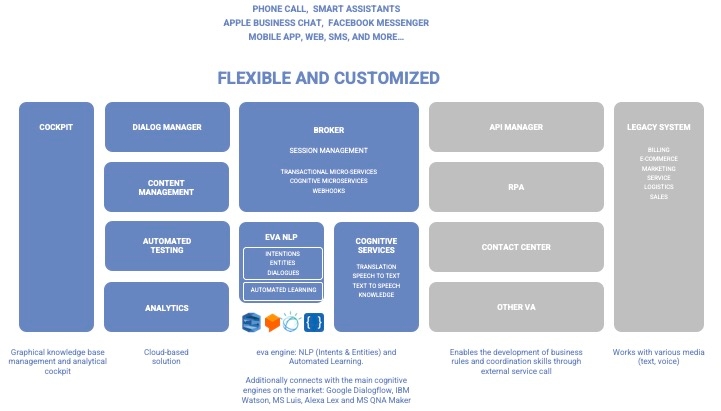
The Dialog Manager is the main feature, the canvas where you create the dialogs and build your virtual agent knowledge base.
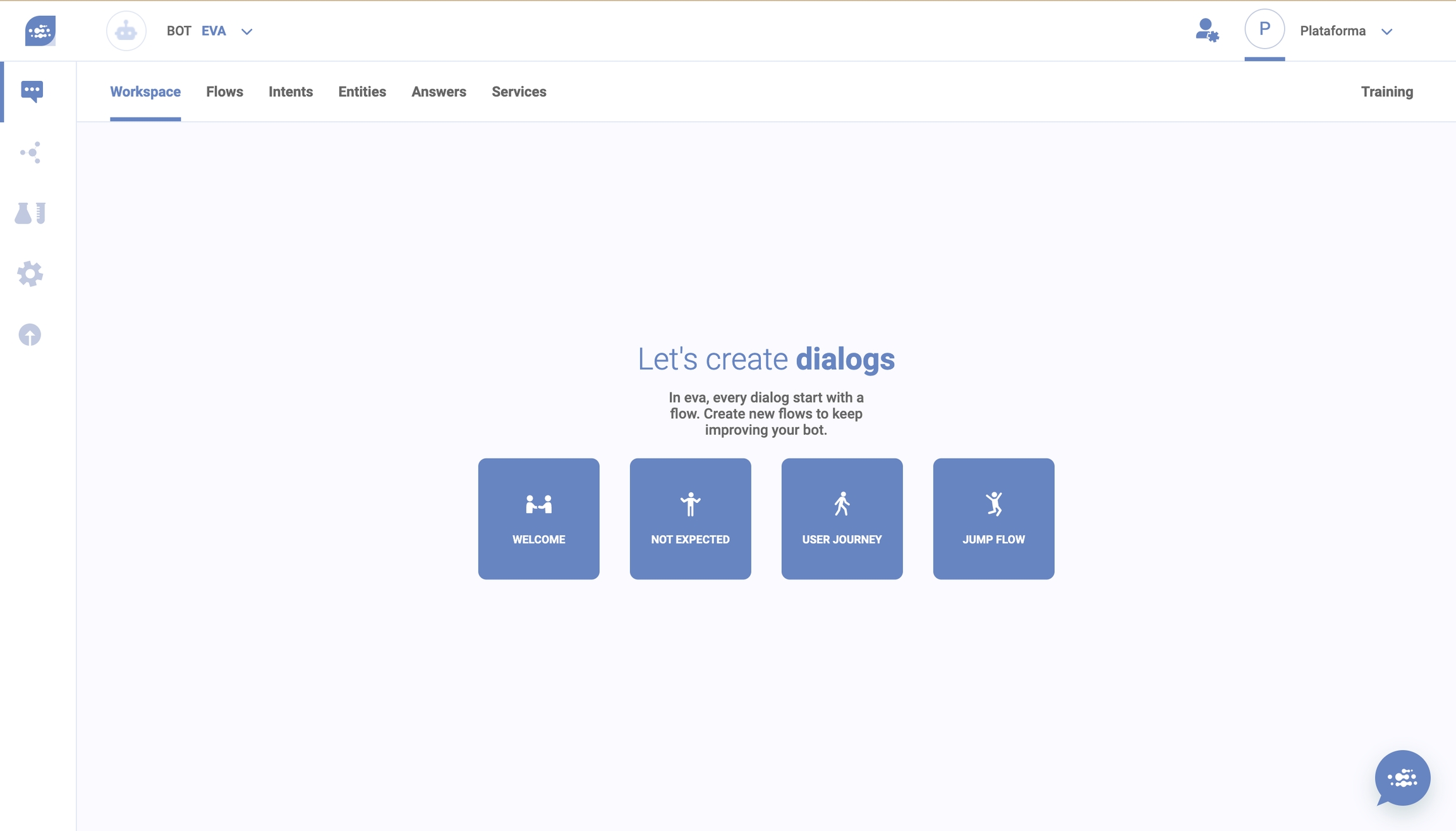
These are the main characters in Dialog Manager:
Workspace
Flows
Cells
Training (if you are using eva NLP)
Knowledge AI
Dashboards - Analytics
Dialog Cells
Intent cell
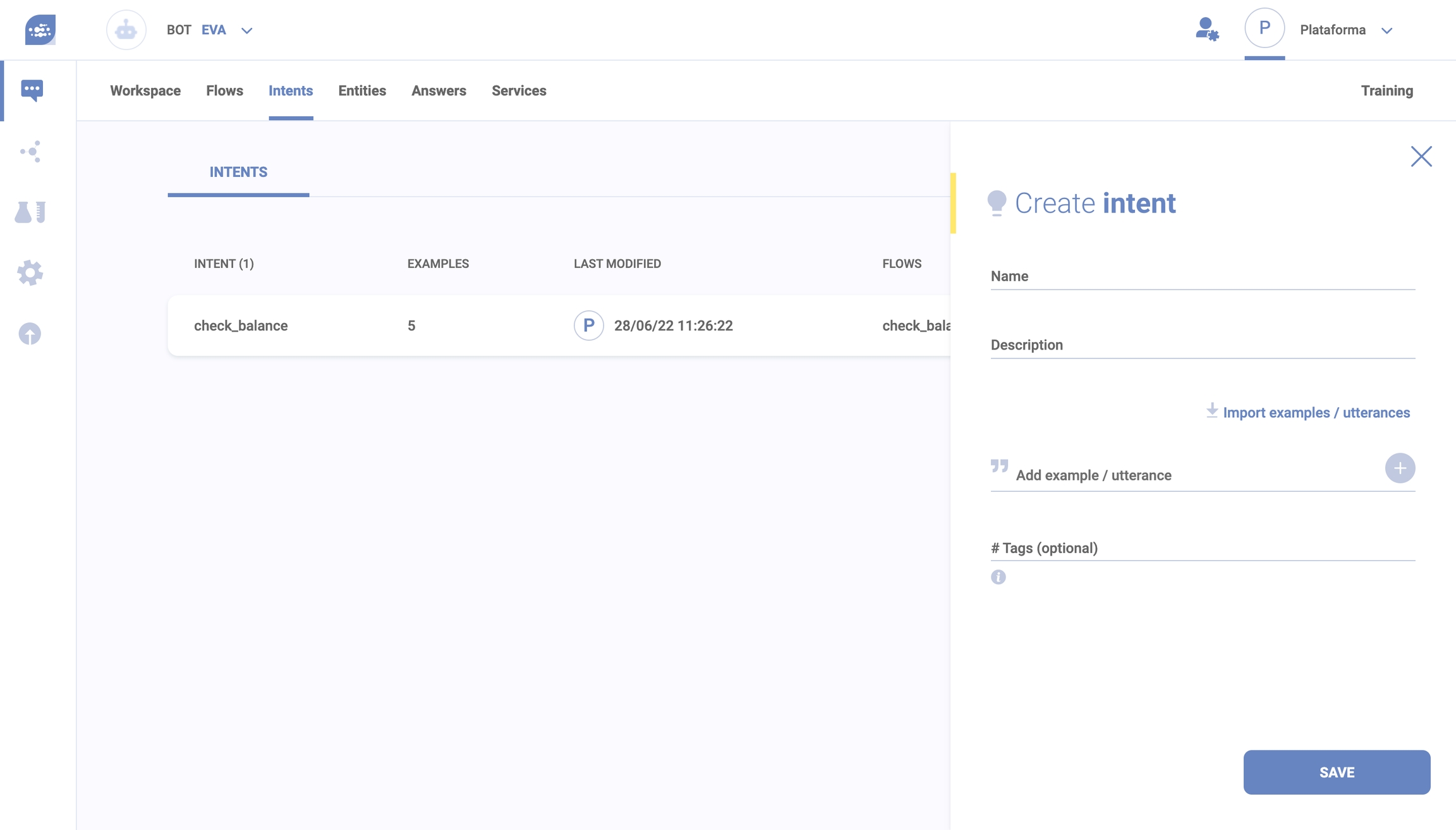
When designing a conversational flow you need to predict the user interactions and the virtual agent responses.
An intent cell will represent the users' interactions. It is the representation of a user's will, in other words, an action.
Usually it is associated with a verb. For example, when the user says he wants to buy something he is expressing a will, that is, an intention.
Since users can express the same will in different ways, the intention cell is composed of examples. The examples are all the possible ways the user can express the same will.
Examples of a purchase intention:
I want to buy
I want to acquire
I want to make a purchase
Entity cell
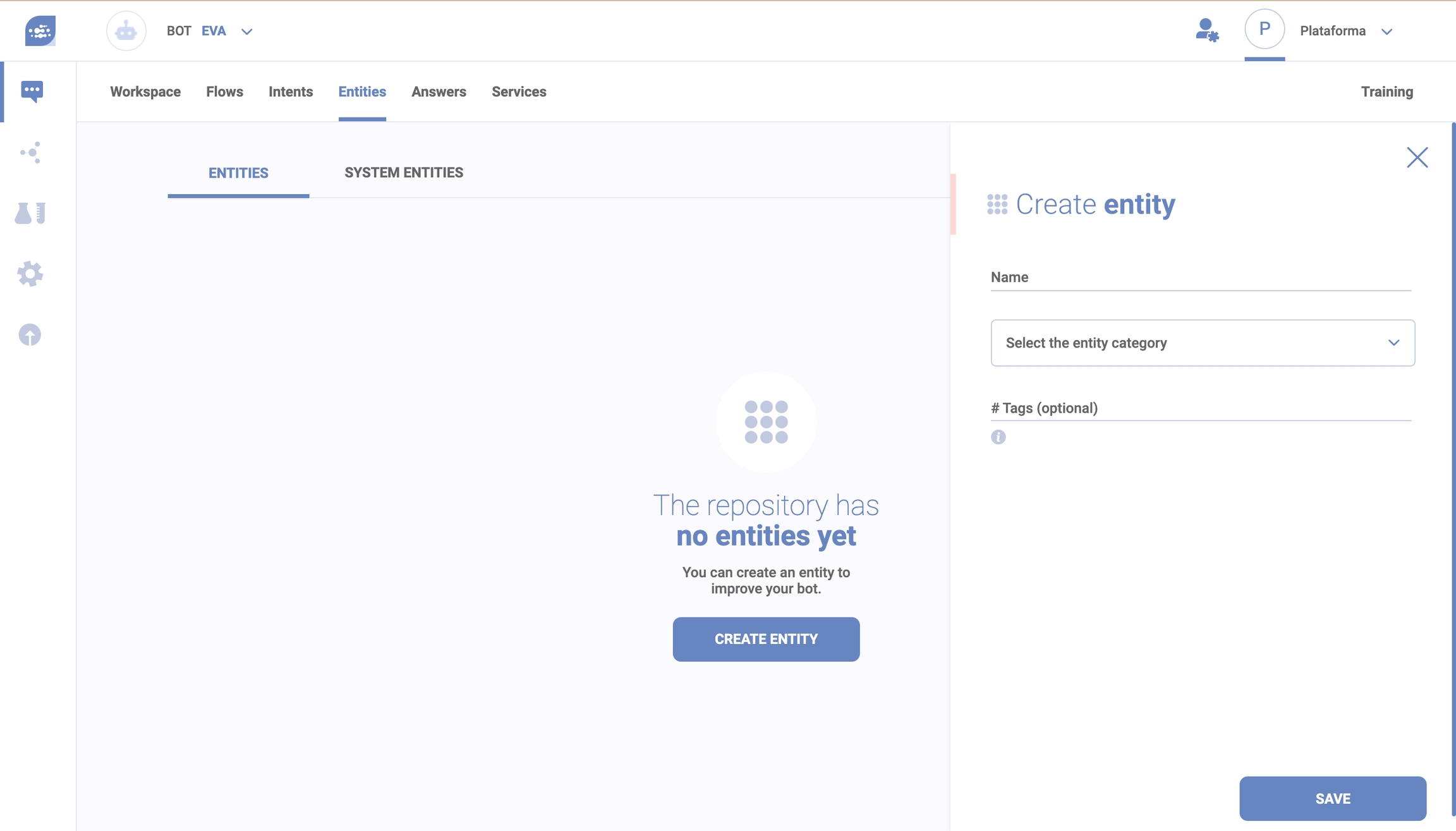
Entities represents a user interaction, but unlike the Intent, it is usually associated with an adjective, noun, product, services, etc. In most cases, entities complement intentions.
For example, if the the user says: "I want to buy an Apple phone"
The terms "cell phone" and "Apple" will be Entities, because they represent a product and a brand.
Entities can also represent a very specific user interaction, such as an email. In cases where it is impossible to map all possible user interactions, such as an email list, we design a standardized term that will cater for this type of interaction. And for this we use standard type entity.
Answer cell
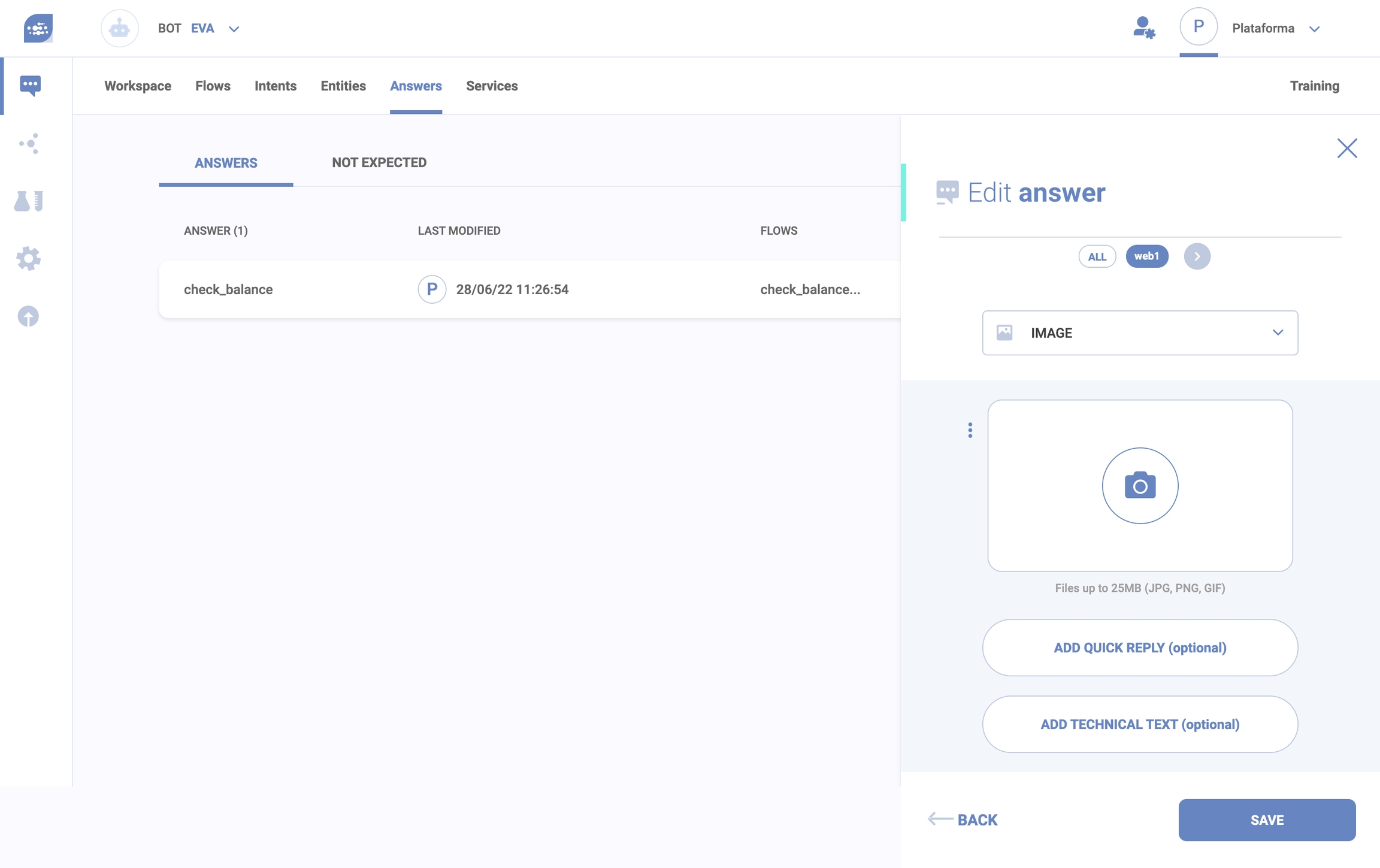
As the name suggests, the Answer cell will bring a virtual agent's feedback to a user's input.
In eva, you can also make your response evaluable. In the bottom corner, you can put a thumbs up and a thumbs down. This way you will know whether the user's feedback was positive or negative.
eva has six types of responses:
1) Simple Answers: the virtual agent predicts answers to user questions
b) Not Expected Answers: the answer given by the virtual agent to an unidentified user demand
c) FAQ: flows built based on answers to intentions
d) Dynamic Answers: through simple codes, brings personalized answers
e) Transactional Answers: when the answer will depend on an API
f) Channel-based Responses: responses that vary according to the channels
Jump cell

As the name suggests, the Jump function allows you to go from the last cell created to any other cell in any flow.
This is perfect to avoid repetition, as well as shortening and simplifying flows.
Service cells
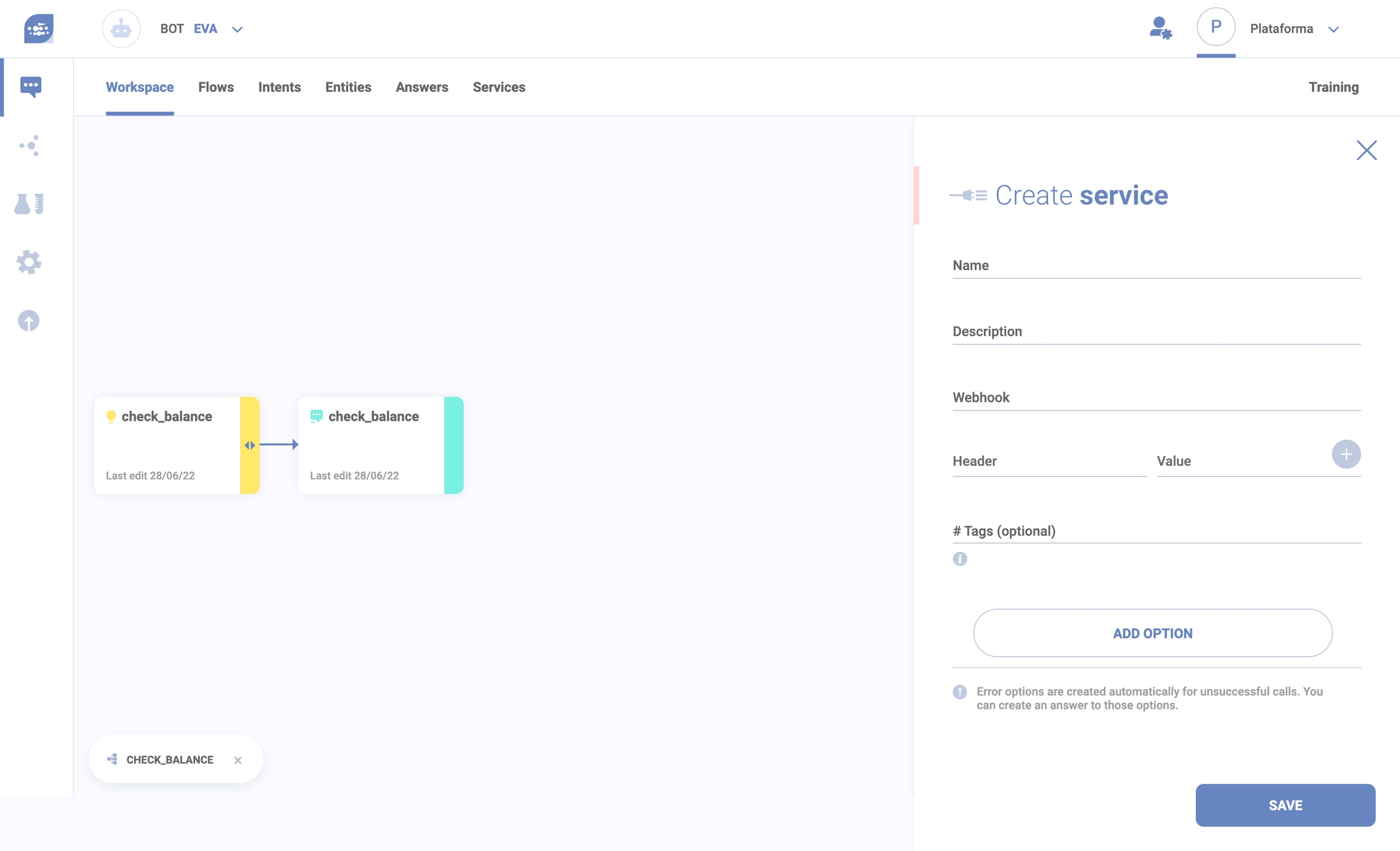
Often, an answer to a user demand will require information that will necessarily be outside the eva, on other servers.
For example, informing a customer's balance, credit card account, closing a purchase on an ecommerce virtual agent, etc.
Here comes the Service cell, which connects the user to eva and the customer.
In it, there is a field to put Webhook. If you have never heard of this expression, it is a protocol used so that an application (APP) on the internet receives real-time information as soon as an event occurs in another web-based application.
Wait-Input cell
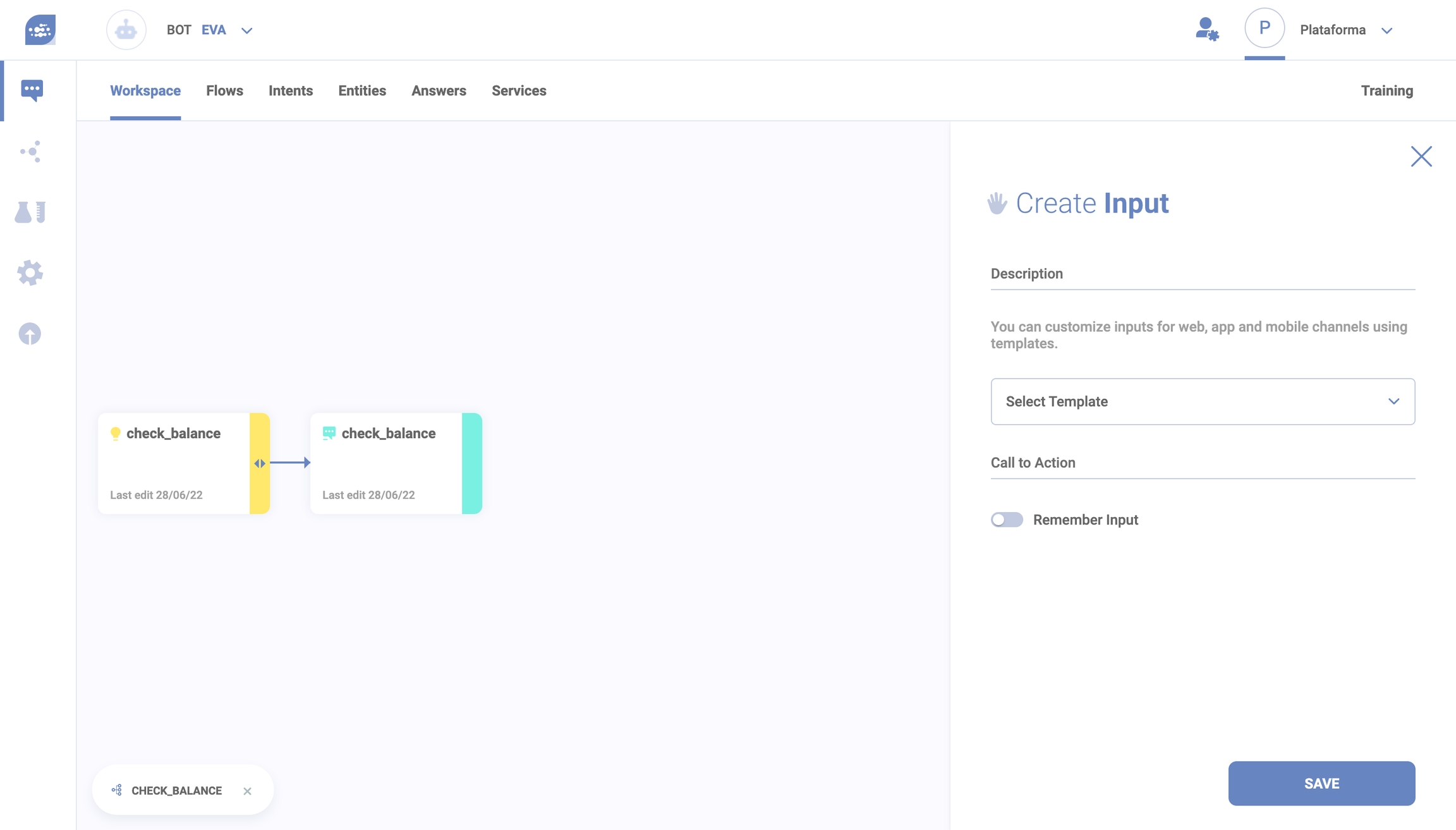
"What is your birth date?", "write your name here", "put your account number here". The Input cell will be responsible for storing this information in the eva.
There are three types:
a) Date Template: allows the insertion of dates.
b) Time Template: allows the insertion of time (hour and minutes)
c) Customizable templates: you can enter locations, zip codes, among other data
End cell
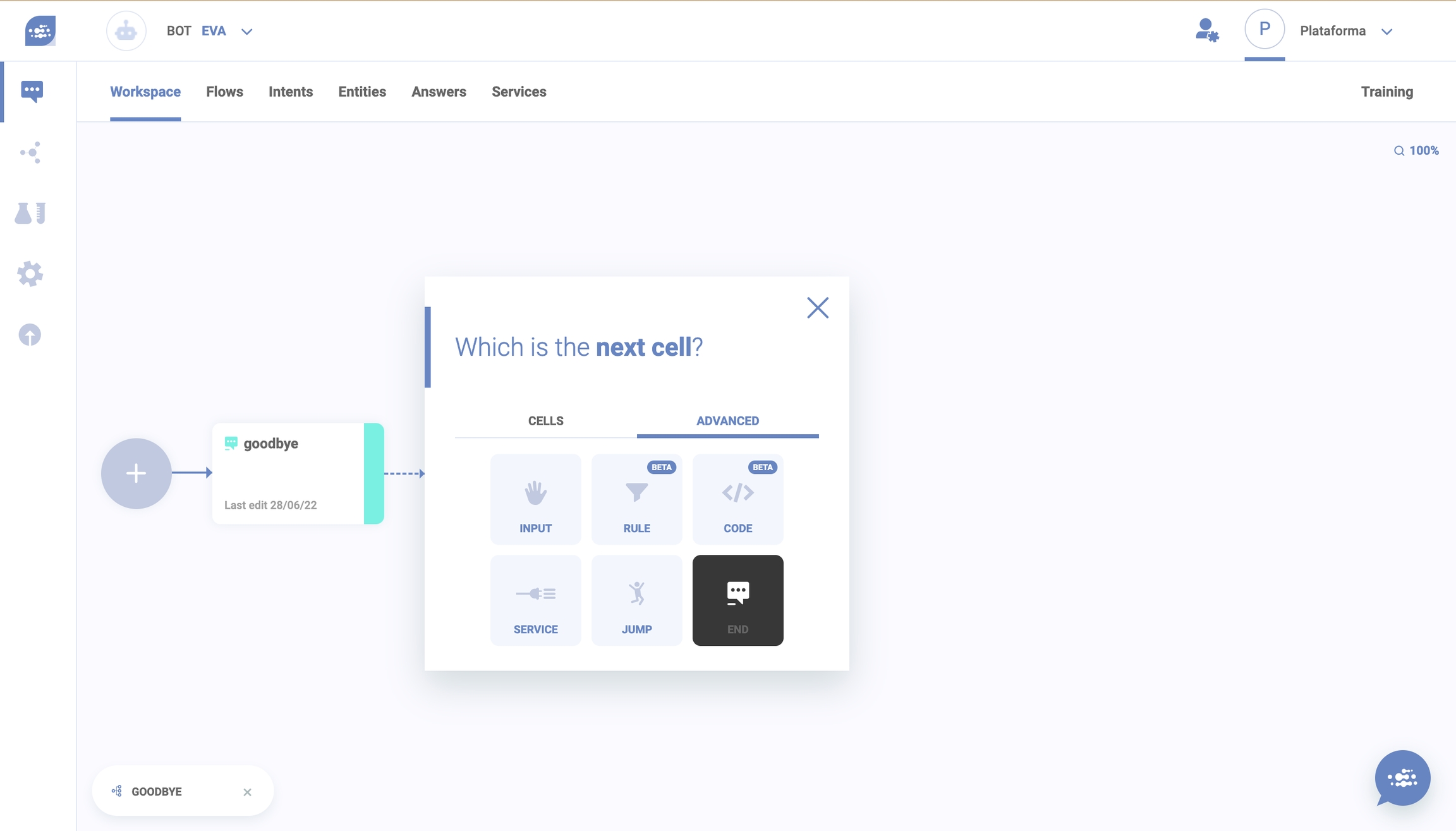
The End Cell works like an end point in a flow. By placing this feature, the virtual agent stops communicating at that point. That is, it will only resume the dialog if the user (the virtual agent's interlocutor) interacts again.
The End Cell is always used in a Jump flow, never in the User Journey (the main one).
Code cell
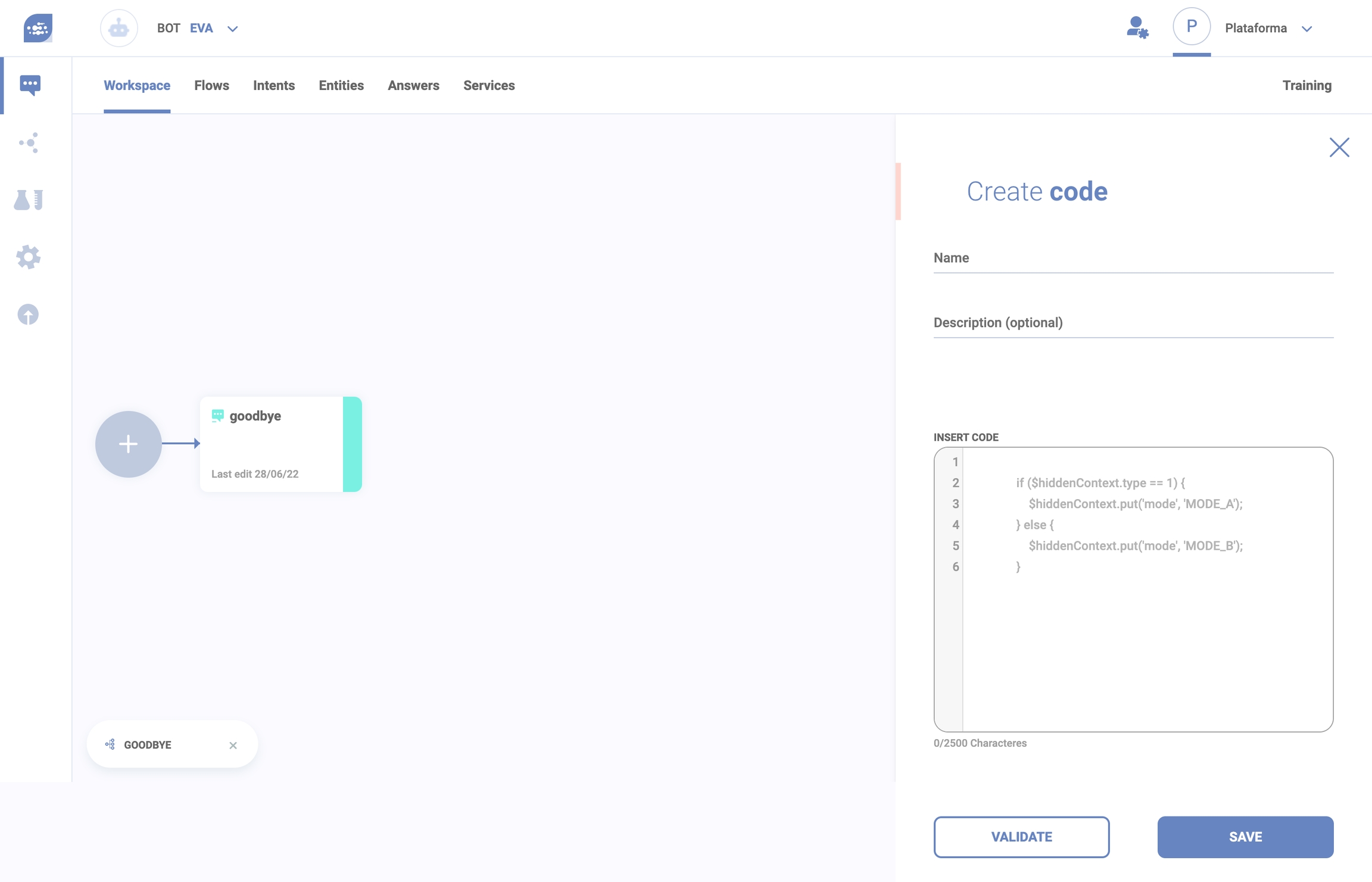
The Code Cell allows you to perform some services without relying on APIs. It offers immense advantages in a flow.
Through the Code Cell it is possible to
Manipulate objects
Anticipate executions and actions
Perform services without the need for APIs
Reduce time and cost
Rule cell
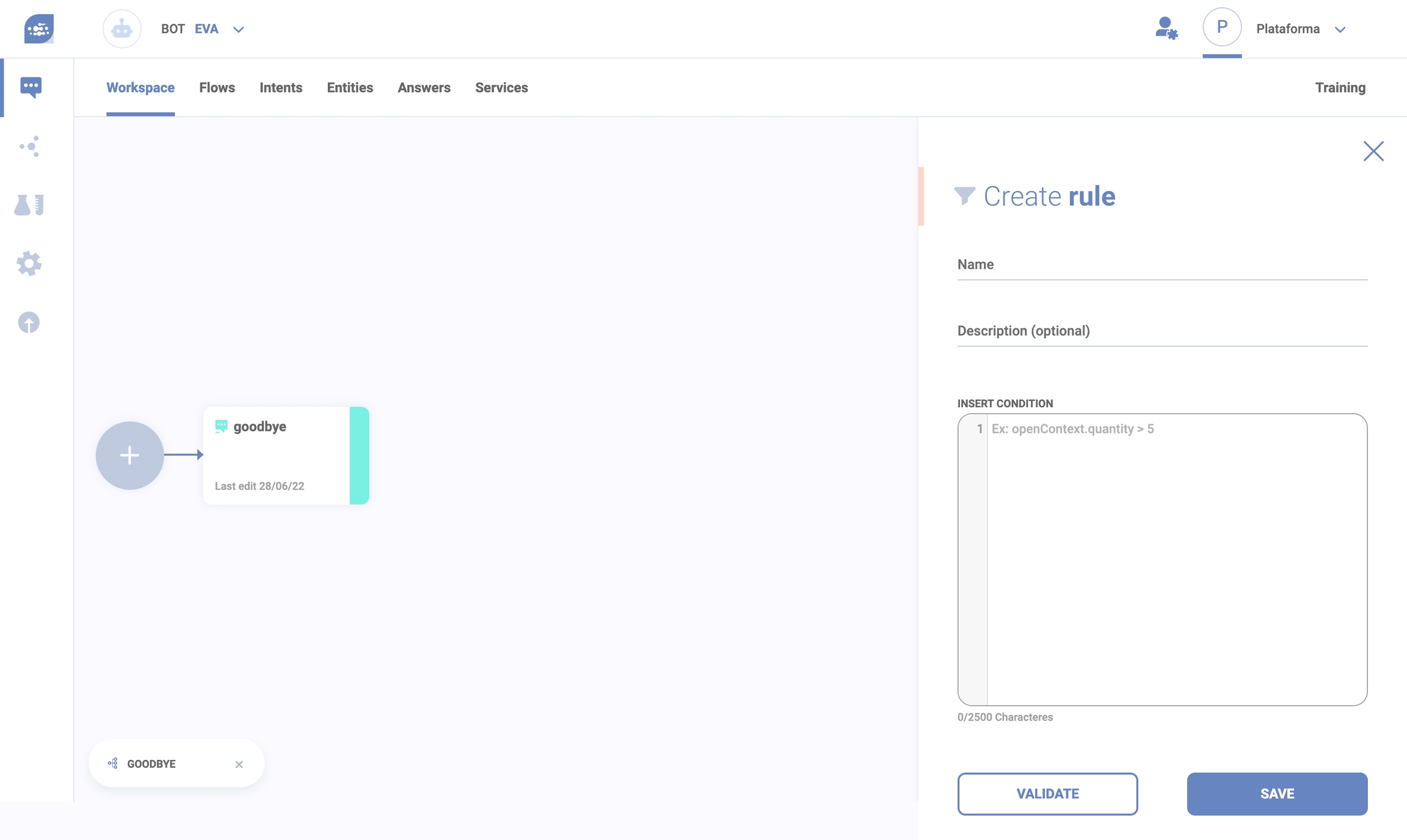
Imagine two users that have the same intention: checking their bank balance. However, one is already logged into the bank and the other is not. In cases like this, the Rule Cell comes in, to steer each user in the right direction.
This is a feature to make your dialog more assertive and much more precise, especially when Intentions and Entities can bring up multiple scenarios.
The language used is JavaScript.
Last updated
Was this helpful?



